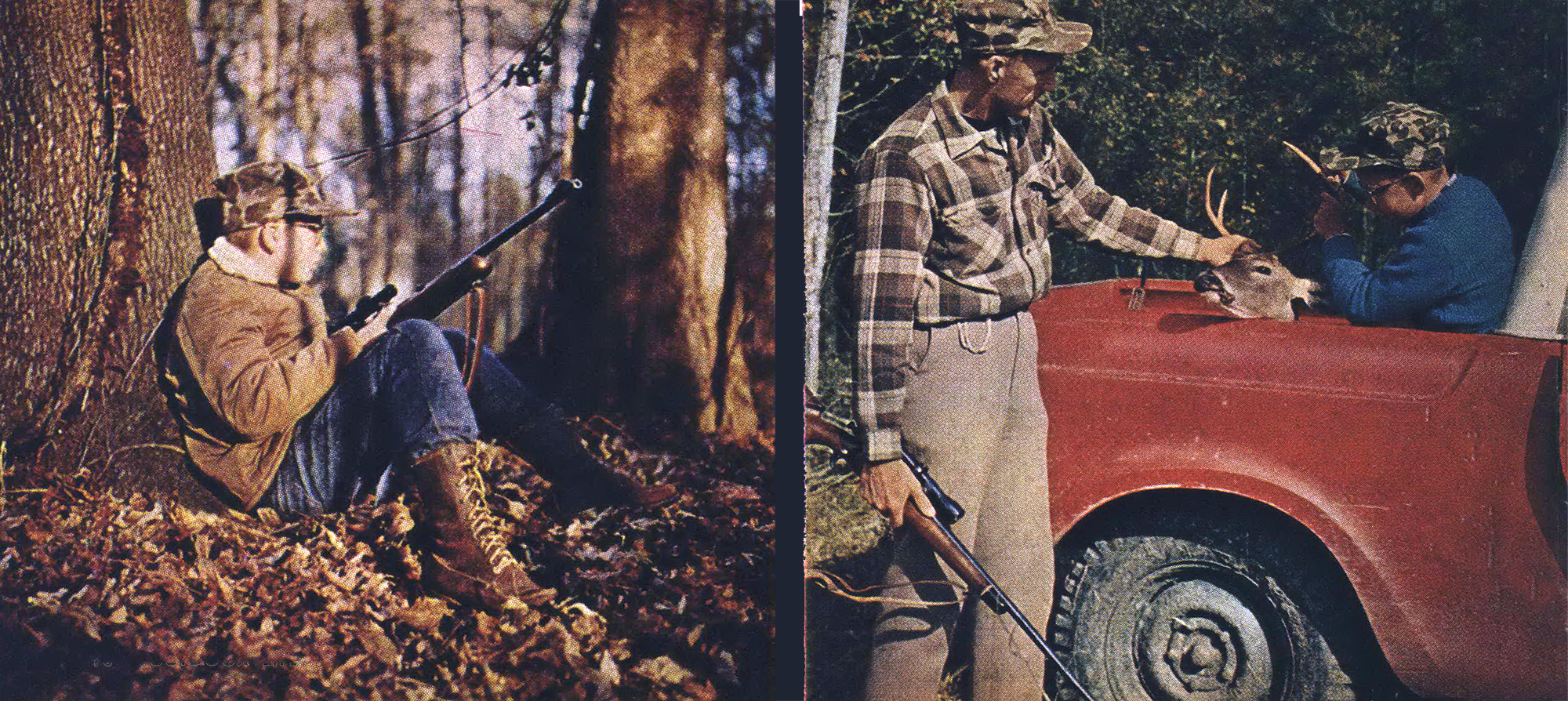This story, “A Deer of Thanksgiving,” originally ran in the November 1964 issue of Outdoor Life.
THE SHOT CAME just as I was easing into position by a dead oak snag. With head down and eyes scanning the ground on which I planned to sit, a precaution against disturbing a cottonmouth, I had trouble coursing the sound.
In the open, mountainous terrain of the West, the sound a heavy-caliber rifle makes when fired is a sharp crack, but in the sound-smothering, hardwood bottomlands of the South, where I was hunting, it becomes a surging boooomm. This one reverberated long enough for me to make sure it had come from my son Tom’s rifle. My watch showed 4 o’clock, just half an hour after I had left my 11-year-old on his first deer stand.
A mixture of parental pride, anxiety, and hope played with my emotions. My first impulse was to return to Tom’s stand to make sure he was all right and to find out what he’d shot at. But I suppressed the urge and went through the motions of hunting for another half an hour.
It was the day after Thanksgiving, 1962, opening day of the Louisiana deer season, but this hunt had really begun two weeks earlier when Tom came into my office.
“I’m ready to go deer hunting this year,” he announced.
I pushed my chair back from the typewriter and looked at him. When I didn’t say anything, Tom continued, “I was 11 last week. I’ve been shooting a .22 for six years, a .410 for four years, a 20 gauge for a year, and I can shoot your .257 Roberts. I’m ready t’go deer hunting.”
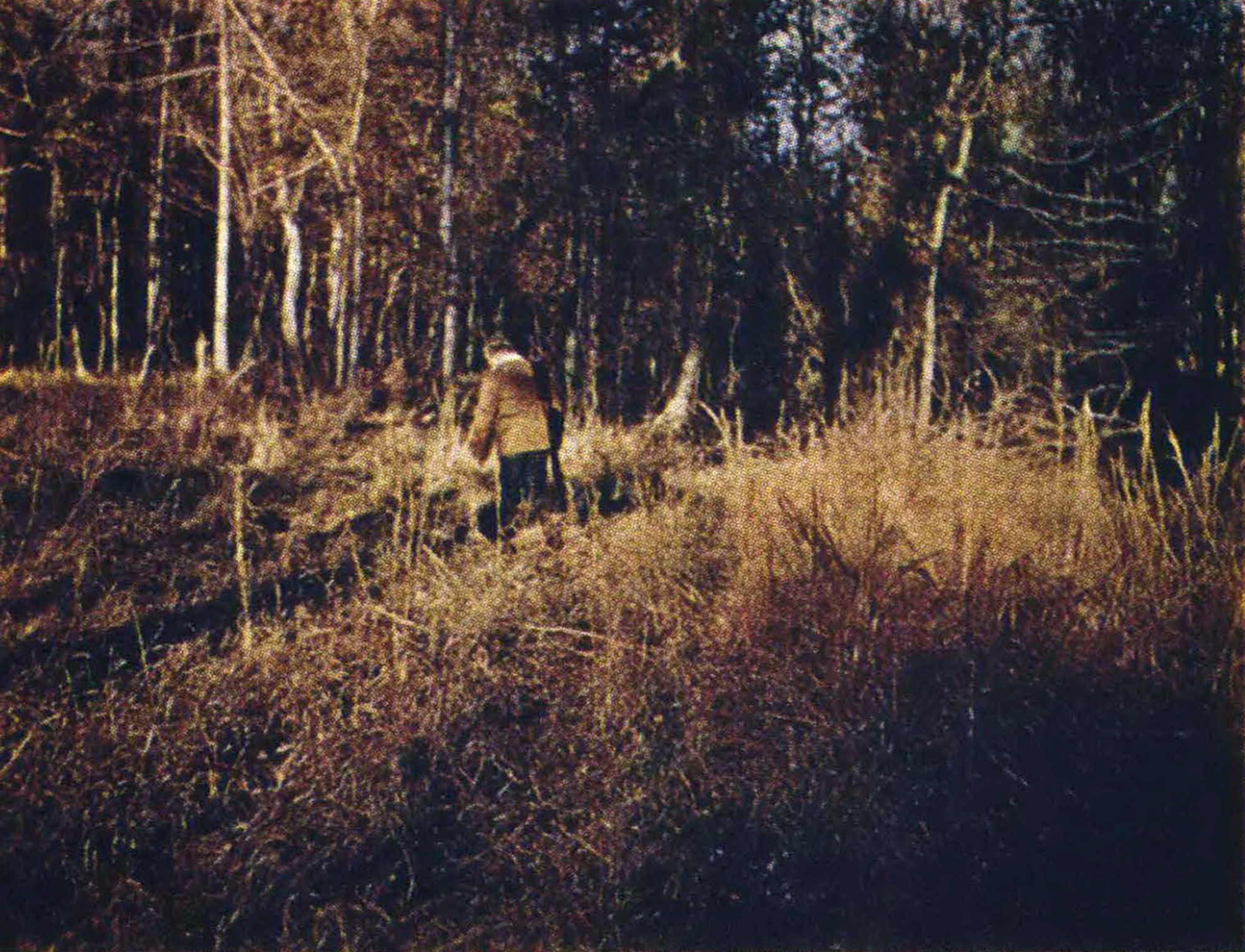
I had previously made it clear to Tom and to his brother Kent, 16 months younger, that they could begin deer hunting when they could handle a rifle big enough to anchor a buck with a reasonably good hit. Tom had done O.K. with the .257 on varmints and targets during the summer.
“I’d like to try your .308, too,” he added with a last gasp of courage. “I think I can shoot it better than I can the .257.”
That made sense, too, since he shoots left-handed. A natural right-hander, Tom had switched over to his left side four years ago when we found that his left eye is his master eye. My .257 Roberts is a custom bolt action, difficult for a lefthander to operate, while my .308 is a Winchester Model 100 automatic.
Half an hour later, we were on the banks of Red River, four miles from my home in Natchitoches, Louisiana, where Tom proceeded to punch .308 holes in the black at 50 yards. He could shoot it.
Getting ready for a hunt is almost as much fun as hunting itself, and we spent two weeks preparing for Tom’s first go at deer. First, I added a 2½X Bushnell scope to the .308, and Tom learned how to sight in a rifle. Trajectory became more than just a word to him. Gunsmith Walter Womack, of Shreveport, came up with a slip-on recoil pad to ease the jolt, and a lace-on pad to raise the comb to scope height.
In Louisiana, hunters under 16 are not required to have a hunting license. But they must have a big-game license, and these are issued free to those under 16. I was to open the season with Clyde Ratcliff on his Elk Ridge Plantation in Tensas Parish, which lies along the Mississippi River on the eastern edge of Louisiana, so quadrangle maps of that area came out of my files and we examined them.
“Get in mind a general picture of the whole area,” I told Tom. “Notice that the big levee runs north and south, parallel to the river. We’ll be hunting west of the levee, so if you walk east you’ll hit it at some point. Keep that in mind and you won’t get lost.” Compass use, treatment for snakebite, clothes requirements, and deer habits were discussed for hours before we left home on opening day, and during the three-hour drive from Natchitoches to Newellton.
We reached Elk Ridge, five miles east of Newellton, just before noon and were greeted by a pair of peacocks, several mallards splashing in the frontyard pond, and a scattering of squirrels in the giant oaks which surround the house. There was no sign of human activity, which was to be expected on opening day, so I drove to the levee and north on the road atop it.
The delta country of northeast Louisiana is a region of fertile alluvial soils which have been deposited there over centuries by flood waters from the Mississippi River. The best topsoil from half the United States, in fact, is now producing bumper crops of cotton, soybeans, corn, and wheat on the cultivated lands, and some of the great hardwood forests of the nation on the uncultivated areas. Pastures thrive on rich soil, abundant rainfall, and mild climate, so the delta is cattle country, too.
The outstanding landmark of the area is the giant levee of the Mississippi River. It zigzags from the Arkansas line almost to the Gulf of Mexico, protecting the land from overflow during high water.
In the delta, the levee is at varying distances from the river, in places a mile or more. The strip between levee and river floods when the water level gets high enough, which has occurred infrequently in recent years with the advent of upstream flood-control impoundments, so most of that acreage is used for timber production or grazing. A few fields behind the levee are cultivated, the owners taking a calculated risk of being flooded out. The levee is 50 feet high and about 200 yards wide at its base, its sides sloping gradually from the road on top.
Tom and I found Clyde on this road about five miles north of Elk Ridge headquarters. He was sprawled on the sod of the levee listening to a hound chop-chopping in the distance. With him was his brother, Buddy Ratcliff; Ed Grace, a neighboring farmer; Iley Gaar, a Newellton merchant who runs a feed and general store when there isn’t anything to hunt or fish for; Jim, Iley’s son; Furman Barnes, a guest from Shreveport, and Jim Wilkerson, Clyde’s nephew.
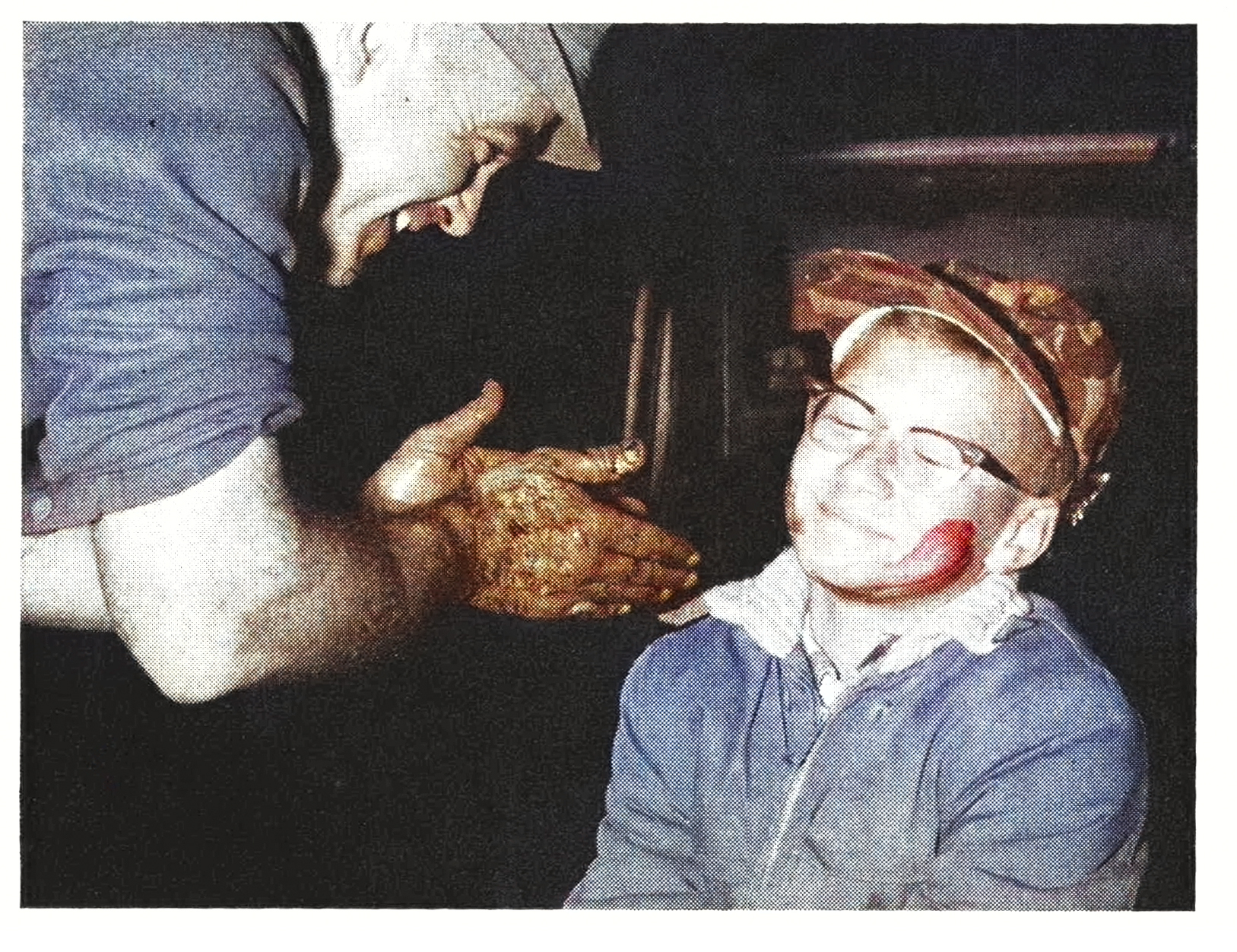
“Just as well you didn’t get here this mawning,” Clyde drawled. “We all might as well have stayed in bed. Didn’t kill a deer. I think Ed missed one, but he swears he didn’t shoot.”
Ed ignored the dig in favor of pulling a sack of groceries from the back of Clyde’s pickup. After eating lunch, the group went their separate ways for the early afternoon hours, which aren’t usually productive for deer hunting.
Iley and his son returned to Newellton to check the store. Buddy and Ed, whose homes aren’t far from Elk Ridge, went home to take a nap. Clyde and Furman went with Tom and me back to Elk Ridge to unload our gear for the afternoon hunt.
WE MET BACK at the levee at 3 o’clock and deployed into the swamp from there. Tom and I were the only ones who hadn’t hunted the area before.
“I’m gonna send Grits and Tom up the east side of the lake,” Clyde told the others as he edged his four-wheeldrive vehicle off the levee and onto a woods road. “Anybody want to ride can hop on. I’m gonna sit in the truck this afternoon . . . best stand I know of.”
After holding back to find out where Tom and I, as first-time guests, were to be placed, the rest of the hunters indicated their hunting areas. Several began hunting right from the levee, while others climbed aboard the truck and dropped off at intervals along the woods road.
A mile or so off the levee, Clyde braked the truck to a stop and pointed through the trees to a finger of water. “Keep to the right side of the lake and I’ll meet you back here about dark. Tom, make him put you in a good spot.”
Clyde Ratcliff, about 40, is a sixfooter with the soft-spoken, gracious manner that befits the typical Southern gentleman, which he is. A graduate of Louisiana State University, Clyde’s a bachelor who manages his farm-ranch plantation with efficiency. He’s an avid outdoorsman, but only a moderately enthusiastic hunter except where ducks are concerned. He hunts deer just “for the pleasure of good company,” more often checking on the needs of other hunters than taking a gun in hand himself.
The truck eased off, we loaded our rifles, and I led the way along the lake edge. Wanting to get into position as soon as possible, I didn’t take time to point out to Tom the abundant deer sign along the way.
A quarter of a mile from the road, we crossed a drainage ditch leading into the lake, and just beyond there was the kind of spot I was looking for. There was a big oak which would serve as a fine backrest and silhouette-breaker, and out front a fallen log which would help cover the movements of an excited youngster.
Whispering to Tom to stay there, I made a fast semicircle of the area, finding several well-used deer trails leading into a brier thicket about 30 yards east of the oak. This will do fine, I thought to myself as I returned to Tom.
I quietly scraped away leaves and sticks from the base of the oak and Tom settled into the cleared spot. He raised the .308, sighted on an imaginary buck at several points, and nodded that his position was good. I stifled an impulse to voice a few last words of advice and caution, gave my son the thumb-to-finger circle that universally means O.K., and moved on down the shore.
For six years, I had given Tom all the knowledge of gun handling and woodscraft I could. He had worn out several Daisy BB guns, fired several thousand rounds of .22 ammunition at targets and varmints, and killed squirrels and doves. Now, as I left him alone with that potent, high-powered rifle, I wondered if I’d done enough.
I turned away from the lake along a deer trail and followed it until another trail joined it. I selected a stand 50 yards off to one side of the intersection and was just settling down into position when . . . booomm.
After half an hour of enforced idleness, I returned to Tom. When he saw me he began bouncing up and down without leaving the ground, and pointing vigorously toward the thicket.
“I got him! I got him!” His whisper could be heard 100 yards away. “He’s right over there in that thicket. You can see his leg sticking up over that log.” He calmed down just slightly as I reached him.
“It’s a buck,” Tom shouted as we approached. “I knew I saw horns in the scope, but after he fell I couldn’t see any. All I could see was his leg and an ear.”
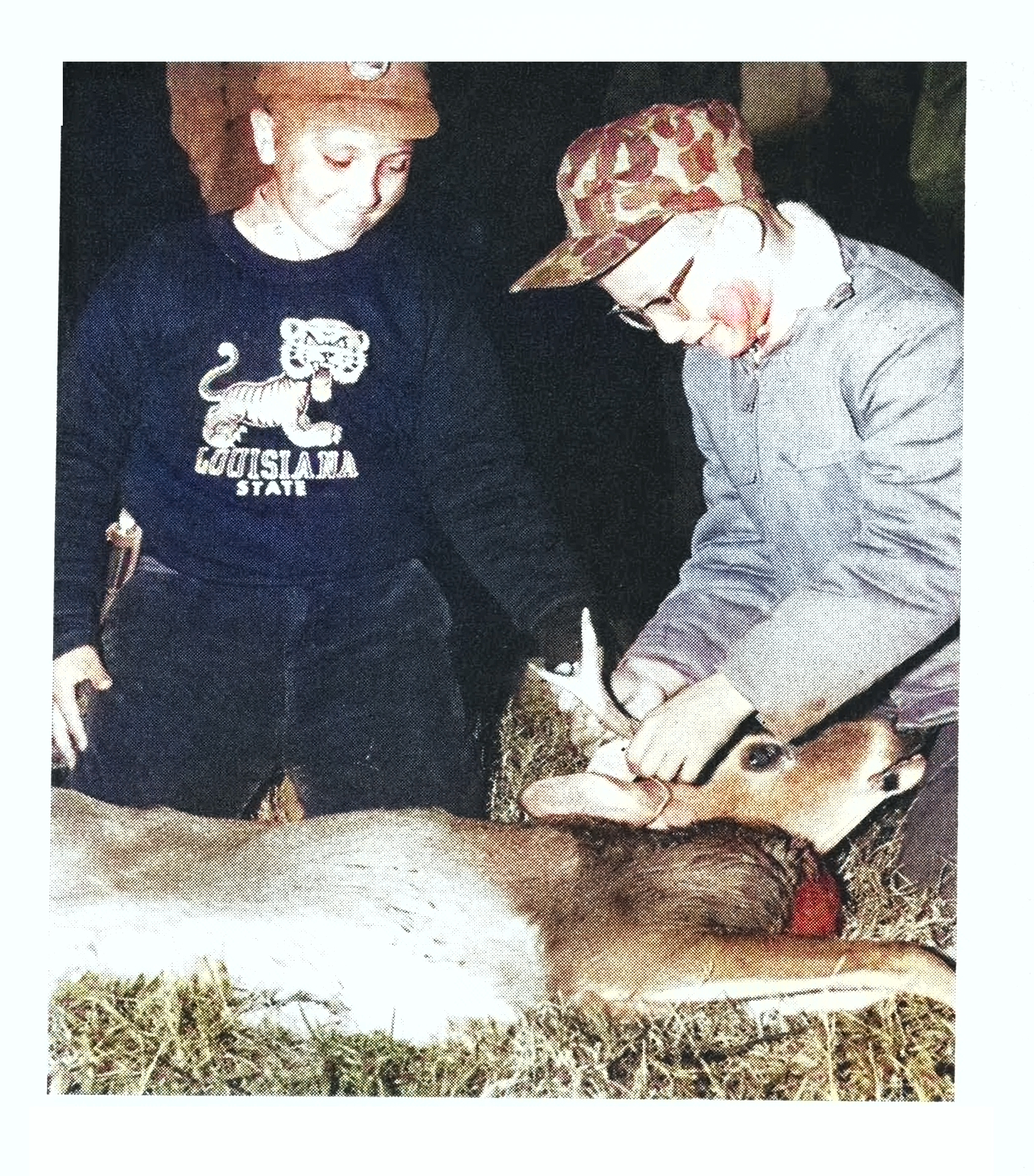
It was a fine five-point buck, and, with dusk setting in, we each grabbed an antler and headed toward the road. Along the way, I began to swell with relief and pride. Tom repeated the tale of the kill several times, and my questions brought out details he was about to overlook.
“I wish I had a recording of that conversation between father and son,” Clyde laughed as we dragged the buck into the clearing by the road. “We’ve been sittin’ here listening, and know the story of Tom’s deer by heart.”
He and Jim Wilkerson had been sitting in the back of the pickup waiting, and I guess Tom and I had been talking louder than we thought.
BACK ON THE LEVEE, Tom had to repeat his tale for the benefit of all hunters. Iley dressed the deer and christened Tom with blood from his first trophy. Relief at reprieve from having his head shoved in the cavity made the smearing of a bit of blood on his cheeks relatively pleasant.
In the half an hour Tom was on his stand before shooting the buck, he saw two other deer moving in the thicket but could see no antlers. He didn’t see the buck coming, just glanced that way and there he was.
“I still couldn’t see horns until I looked through the scope,” Tom related. “Then I just put the post on his shoulder and shot him.”
The range was only 35 yards, and the 150-grain Silvertip bullet hit a bit high, just behind the shoulder. It shattered the spine and dropped the buck instantly. I had cautioned Tom not to go to a deer if he knocked one down, but to stay ready to shoot again should he get up. He had followed my instructions, though there was no danger of this one running off.
Next morning, Tom and I were back at our same stands before daybreak. He couldn’t be budged from his lucky spot, and I wanted to give my crossing a fair chance. The limit that year was two deer, but only one a day. In the area we were hunting, however, only bucks were legal.
The coming of dawn in the deep hardwood bottoms of the South is always a stirring thing to me, and this one was no exception. Even before I could distinguish the individual limbs of the trees, the quick, clipped notes of a cardinal announced a new day.
The deer herd in Tensas Parish was the first in Louisiana to mushroom rapidly from a nucleus to oversaturation. Physical conditions of the terrain -fine hardwood forests laced with streams and sloughs, row crops upon which deer foraged, and a winter oat crop that nurtured the herd when natural food was at its lowest ebb-were excellent. Iron-fisted protection by a sheriff, however, was the key that unlocked the reproductive potential of the Tensas whitetails.
Then the herd erupted. In late winter, 200 or 300 deer could frequently be seen in one oat field along the highway. Collision with deer became a highway hazard. Deer densities of greater than one per 10 acres were common. Crop damage became tremendous.
Despite repeated warnings from the Louisiana Wild Life and Fisheries Commission that the herd must be reduced, neither landowners nor the hunting public would go along with doe shooting. The buck law had been oversold.
VARIOUS METHODS for reducing the herd were tried in the late 1950’s permits issued to farmers to shoot deer causing damage, extra doe permits, and even one fiasco that sent game wardens into overpopulated areas to hunt deer at night.
The land in Tensas, and in neighboring Madison Parish, is all privately owned and vigorously patrolled. Under these conditions herd reduction was erratic, even when an either-sex season was finally declared.
In areas where herd reduction eventually began, the quality of the bucks has risen, with heavy racks and bigger deer becoming more common. In a few others, where there are still too many animals for the range, the size of deer and quality of the antlers have deteriorated.
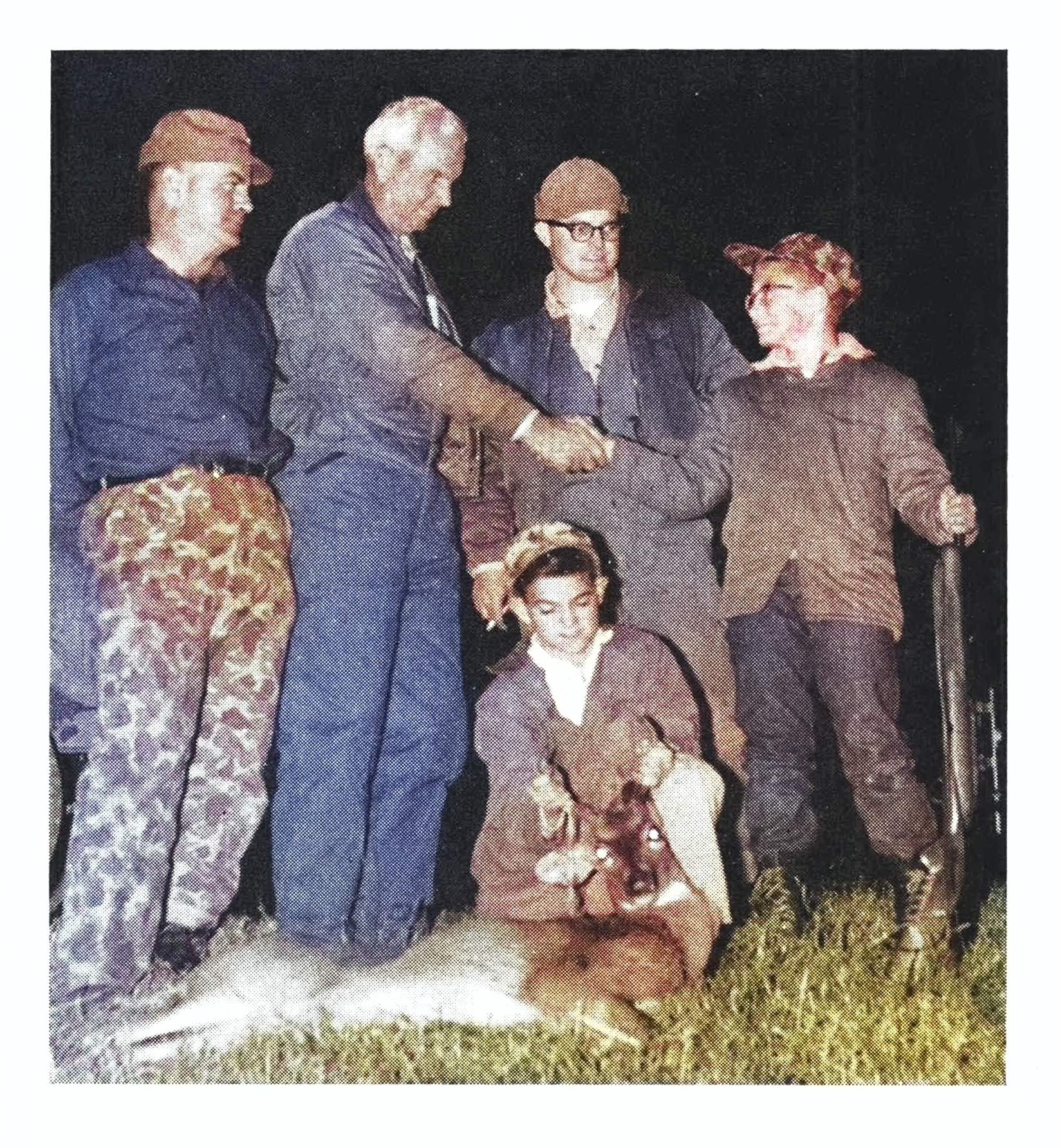
Overall, the delta portion of Louisiana is on the road to recovery from overpopulation of deer. The hunting can only be described as good to excellent. In the rest of Louisiana, the trapping and transplanting program of the Wild Life and Fisheries Commission has put huntable populations of deer in the backyards of most hunters.
I mulled over the Louisiana deer picture as dawn became day. It wasn’t cold, but the chill seemed to become sharper as the sun eased into view. But a movement out front brought to a stop my worry about whether Tom was warm enough or not. My binoculars showed no antlers on the deer that flowed silently through the woods. I waited for a buck to follow, but none did.
MY STAND, I came to realize, wasn’t the best I’d ever selected. It covered the deer trails which crossed 50 yards away, but the dead oak which served as my backrest was almost in the middle of a 50-yard clearing. There weren’t any screening bushes or shrubs nearby. I considered moving, but the snap of a twig behind me ended that thought. I turned my head slowly until I could see over my right shoulder. Nothing … but was that a movement by the sweetgum tree?
“The trouble with most deer hunters,” my Arkansas buddy Lewis Rush once told me, “is that they don’t believe their eyes. If you think you saw something move, something did move. Believe what you see.”
The words came back, so I believed and froze. Squirrel? Woodpecker? The movement finally came again, and, at 20 yards, I recognized it as the ear of a deer.
A doe ambled out in full view, stopping now and then for a bite of something on the ground. I scarcely breathed, waiting for a buck to follow. But another slickhead stepped into view only 30 feet from where I sat.
Close on her heels was the buck, and at that distance I felt as if he were in my lap. The rack looked big at first, but then I saw it was only a fourpointer with long, slender tines typical of deer on overpopulated ranges. He had suffered nutritional deficiencies at some time, but not during the past few months. He was sleek and fat.
My sporterized .30/06 Springfield was across my lap pointing to my left. The deer were to my right, only two jumps from a thicket which I knew they could reach before I could shoot. I let them feed across the opening into the edge of the brush, then eased my rifle into position.
I was in full view of the buck, and, at 10 yards, I was sure he could hear my heart pounding. When he looked up at me I pulled the head-in-the-sand bit. I shut my eyes and tried to relax without moving. If I couldn’t see him maybe he couldn’t see me.
To my surprise, the three deer fed leisurely across the opening, pausing frequently to look and listen. When they were behind the first fringe of bushes, I made my move, inches at a time. But before the muzzle was halfway around, the deer exploded into flight.
Their first leap carried them out of sight, but I rolled over to my knees, rifle at ready, knowing I had fluffed the chance. Then down through the woods I saw a shape fill an opening between two trees and stop. Through the 4X Weaver scope I saw it was a deer.
Buck or doe? Odds were two to one against me. Then the unmistakable shine of an antler came into the field of view as the buck turned to look back. I moved the crosshairs back to the shoulder and touched off a shot.
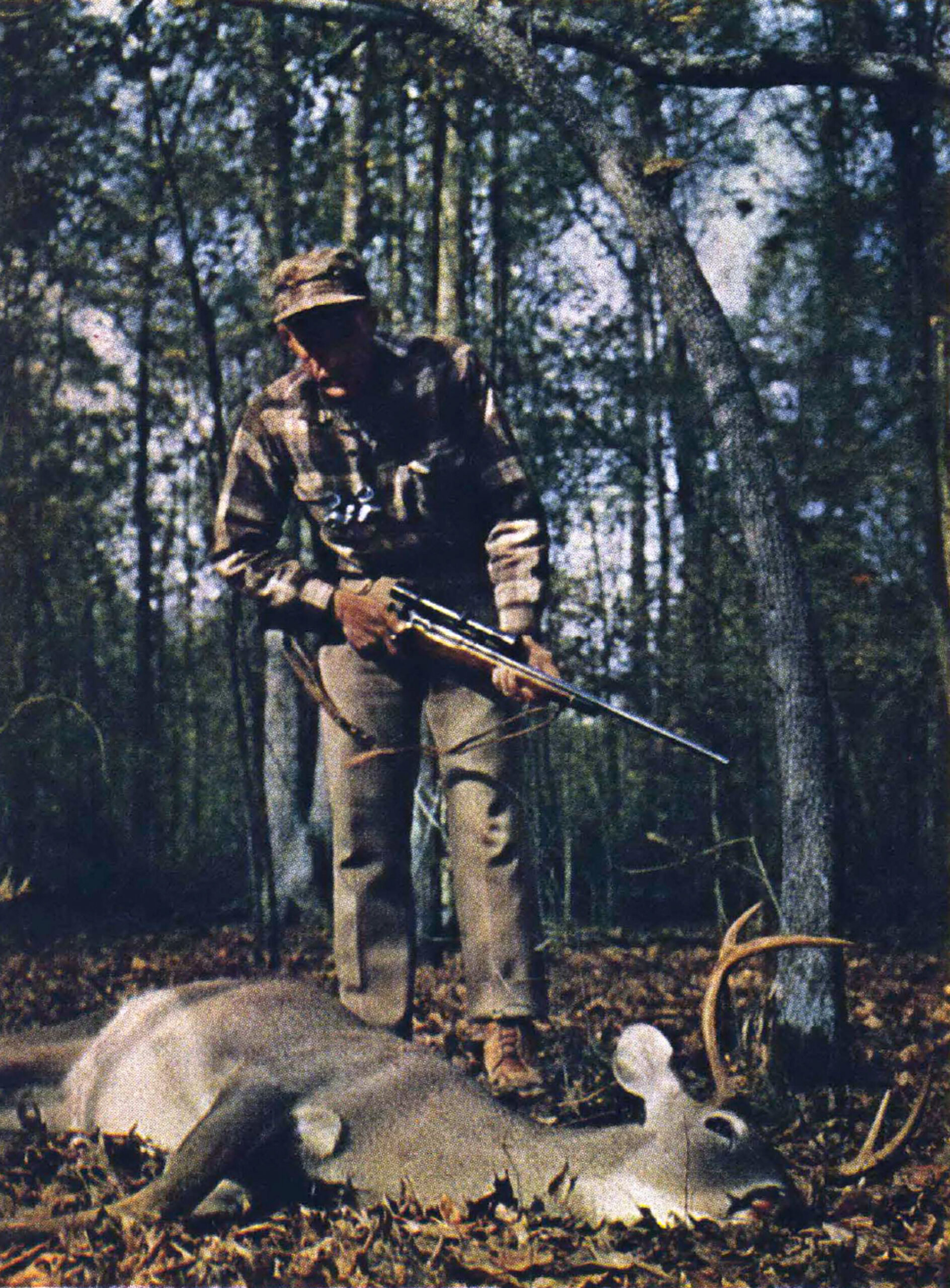
The sound of the buck in full flight died away in the distance, as I tried in vain to see him again after the shot. I settled back against my tree, noted the spot where the deer had been when I fired, and waited for half an hour.
It was about 100 yards to where I thought the buck had been standing. Moving toward the place, I tried to remember my sight picture when I fired, and decided that it was good.
Blood trails on dark, wet leaves in the swamps of the South aren’t conspicuous, but this one wasn’t difficult. With any decent hit, I felt that the buck would have stiffened up or bled to death. I followed the trail slowly and quietly, rifle at ready.
The precaution wasn’t necessary. The buck had run only 75 yards before dropping. The 180-grain bullet had made a shambles of his lungs.
It was too good an opportunity to miss, so I returned for Tom and brought him to where the buck had been at the shot.
“I hit a deer that was standing right here,” I told him, “and he ran in that direction. See if you can find him.”
Tom started off on the trail, missed the first blood sign, lost the trail, doubled back and found it, and finally saw the blood.
Tom is three inches under five feet and weighs 90 pounds. Watching him trying to puzzle out the trail, I reflected on a couple of minor problems he’s had to cope with as a hunter. Near-sightedness makes strong glasses necessary, and having to switch from right to left-hand shooting had held back his progress a bit.
It was obvious, however, from the way he concentrated on the blood trail, that nothing had dimmed his love of hunting. Head down, examining every leaf, Tom almost stepped on the buck before he saw it. He was startled but pleased. So was I.
During the morning hunt Tom had seen five does. We hunted that afternoon and the next day and the story was the same—no more horns. I couldn’t have planned it better. Tom’s first buck had come almost too easily, and it was good for him to learn that it doesn’t always happen that way.
My buck was just right. It was big enough to retain the respect due his elders by a youngster, but not too big to make Tom’s suffer by comparison. Fact is, his had five points and mine four, a detail which Tom frequently pointed out.
On the drive back to Natchitoches, I was lost in happy thoughts about the hunt. It was certainly one time when all the pieces fell into place.
“Boy, I really had a good time,” Tom said for the 10th time. “The only thing wrong was I only got to shoot one time.”
Read more OL+ stories.
